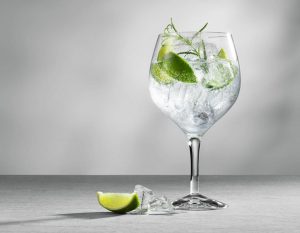Gin Guide

The name gin comes from the French word for juniper; Genevieve.
There is very little that defines gin aside from it being a neutral alcohol that derives its flavours predominantly from Juniper berries. So basically vodka, but with juniper berries. Now, Juniper berries, while predominant, are not the only flavours added. Other herbs, florals, spice and fruit flavours are added.
The aromatics can be added and distilled WITH the spirit in which case this is a LONDON DRY. It can be made anywhere and does not necessarily just London. (It could technically even be spirits from Kenya!)
If the aromatics are added after, the gin can only be classified as a Distilled gin.
I had the pleasure of meeting top South African sommelier Joe Dhafana, during his trip to Nairobi and he explained to us that, in South Africa, aside from the presence of Juniper the ABV MUST be 43% and above.
Gin really has no limitations; it can be made anywhere and by anybody and still be gin.
London Dry
Gin is not a sipping drink. It usually is enjoyed as a mixed drink or simply with tonic water.
You may also wonder what gin has to do with teacups. Well, back in the day when ladies who lunch wanted to enjoy a little tipple, without the ensuing judgement, they’d have their GnTs served up like tea. How about introducing this way of enjoying spirits in Kenya?
Beefeater is A quintessential LONDON DRY gin and is stocked by several alcohol retailers. This is a popular spirit to purchase online in Kenya especially! Essentially, LONDON DRY means that the 9 botanicals featuring bold juniper, zesty Seville Orange and Lemon Peel were distilled with the spirit and nothing was added after the distillation was done.
It’s made with big juniper character and strong citrus notes, this is an authentic London Dry for those that enjoy the real taste of gin. This gin pairs well with a straight Indian tonic or for spice, try the KO turmeric and chilli.
Not London Dry Gins
Hendricks gin is a well-loved gin crafted in Scotland. It, however, is NOT a London dry gin. Not because it’s not made in London, but because two of its botanicals, rose and cucumber are added AFTER the distillation is done.
Even though, for this reason, it can only be classified as a distilled gin, the freshness of the rose and cucumber is preserved and really comes through. And, I can see why they did it. Pair this gin with a light tonic such as the KO Light Tonic water or, no surprises here, the KO Rose and Cucumber tonic! For most alcohol retailers agree that this tends to be a favourite on the shelf!
The above two are highly regarded gins but, they are produced in large quantities by large distillers.
Craft Gins
There is a new trend of ‘craft’ gins. This basically describes gins made by small producers and typically in small batches. It is argued that small producers pay more attention to their gin making process but, that is not for me or for the alcohol retailers to decide. The taste is in the… gin.
Bloedlemoen (pronounced Blue’d Le Moon) is a handcrafted South African gin distilled in Cape Town and made from the luscious Tarocco Blood Orange. It proudly boasts as the first Blood Orange Gin in the world. It is crafted using 10 botanicals in the classic London Dry fashion. This gin pairs excellently with the Barker and Quin Honeybush and Orange tonic water.
Elephant London Dry Gin is a handcrafted premium gin of 45% ABV that captures the spirit of Africa. Its innovative blend of 14 botanicals combines rare African ingredients with fresh apples that make Elephant Gin distinct from any other. It is crafted in Germany but with an African spirit (no pun intended, haha). 15% of profits go to elephant conservation efforts. Pair this delightful gin with the Barker and Quin Marula tonic obviously!
Pink Craft Gins
There is a ‘pink gin that was made in the past that was a sort of cocktail with bitters that turned the drink pink. That’s a far cry from the pink gin of today. Now, the colour pink is usually added on and the gin is typically flavoured gin. It may have strawberry flavours such as in the Beefeater Pink or as in the case of Musgrave Pink, rosehip and rosewater. Pair the Musgrave pink with Barker and Quin tonic water.
Most of these gins and other spirits in Kenya are easily accessible for purchases. In fact, many of spirits are available online in Kenya. So now that you have some knowledge on gins and what to mix them with, grab some and let’s be-gin (see what I did there..?)
